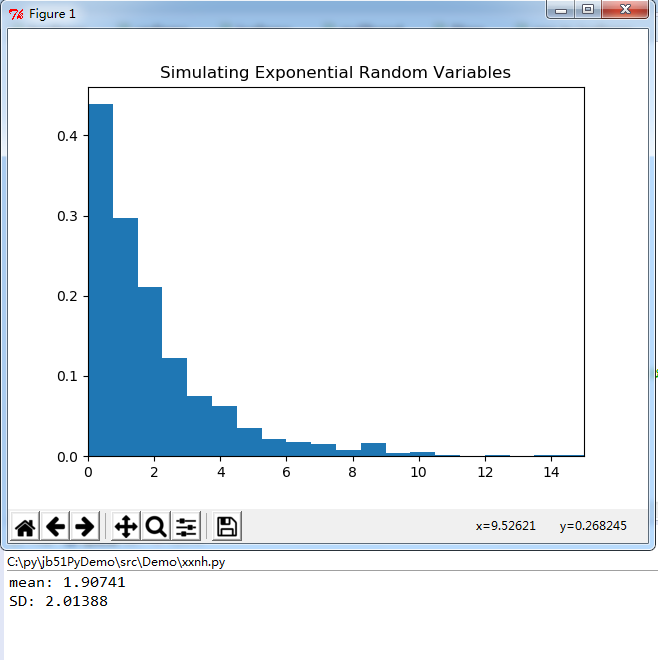本文实例讲述了python实现的各种常见分布算法。分享给大家供大家参考,具体如下:
|
1
2
3
4
5
6
7
8
9
10
11
12
13
14
15
16
17
18
19
20
21
22
23
24
25
26
27
28
29
30
31
32
33
34
35
36
37
38
39
40
41
42
43
44
45
46
47
48
49
50
51
52
53
54
55
56
57
58
59
60
61
62
63
64
65
66
67
68
69
70
71
72
73
74
75
76
77
78
79
80
81
82
83
84
85
86
87
88
89
90
91
92
93
94
95
96
97
98
99
100
101
102
103
104
105
106
107
108
109
110
111
112
113
114
115
116
117
118
119
120
121
122
123
124
125
126
127
128
129
130
131
132
133
134
135
136
|
#-*- encoding:utf-8 -*-import numpy as npfrom scipy import statsimport matplotlib.pyplot as plt######################二项分布#####################def test_binom_pmf(): ''' 为离散分布 二项分布的例子:抛掷10次硬币,恰好两次正面朝上的概率是多少? ''' n = 10#独立实验次数 p = 0.5#每次正面朝上概率 k = np.arange(0,11)#0-10次正面朝上概率 binomial = stats.binom.pmf(k,n,p) print binomial#概率和为1 print sum(binomial) print binomial[2] plt.plot(k, binomial,'o-') plt.title('binomial: n=%i , p=%.2f' % (n,p),fontsize=15) plt.xlabel('number of successes') plt.ylabel('probability of success',fontsize=15) plt.show()def test_binom_rvs(): ''' 为离散分布 使用.rvs函数模拟一个二项随机变量,其中参数size指定你要进行模拟的次数。我让python返回10000个参数为n和p的二项式随机变量 进行10000次实验,每次抛10次硬币,统计有几次正面朝上,最后统计每次实验正面朝上的次数 ''' binom_sim = data = stats.binom.rvs(n=10,p=0.3,size=10000) print len(binom_sim) print "mean: %g" % np.mean(binom_sim) print "sd: %g" % np.std(binom_sim,ddof=1) plt.hist(binom_sim,bins=10,normed=true) plt.xlabel('x') plt.ylabel('density') plt.show()######################泊松分布#####################def test_poisson_pmf(): ''' 泊松分布的例子:已知某路口发生事故的比率是每天2次,那么在此处一天内发生4次事故的概率是多少? 泊松分布的输出是一个数列,包含了发生0次、1次、2次,直到10次事故的概率。 ''' rate = 2 n = np.arange(0,10) y = stats.poisson.pmf(n,rate) print y plt.plot(n, y, 'o-') plt.title('poisson: rate=%i' % (rate), fontsize=15) plt.xlabel('number of accidents') plt.ylabel('probability of number accidents', fontsize=15) plt.show()def test_poisson_rvs(): ''' 模拟1000个服从泊松分布的随机变量 ''' data = stats.poisson.rvs(mu=2, loc=0, size=1000) print "mean: %g" % np.mean(data) print "sd: %g" % np.std(data, ddof=1) rate = 2 n = np.arange(0,10) y = stats.poisson.rvs(n,rate) print y plt.plot(n, y, 'o-') plt.title('poisson: rate=%i' % (rate), fontsize=15) plt.xlabel('number of accidents') plt.ylabel('probability of number accidents', fontsize=15) plt.show()######################正态分布#####################def test_norm_pmf(): ''' 正态分布是一种连续分布,其函数可以在实线上的任何地方取值。 正态分布由两个参数描述:分布的平均值μ和方差σ2 。 ''' mu = 0#mean sigma = 1#standard deviation x = np.arange(-5,5,0.1) y = stats.norm.pdf(x,0,1) print y plt.plot(x, y) plt.title('normal: $\mu$=%.1f, $\sigma^2$=%.1f' % (mu,sigma)) plt.xlabel('x') plt.ylabel('probability density', fontsize=15) plt.show()######################beta分布#####################def test_beta_pmf(): ''' β分布是一个取值在 [0, 1] 之间的连续分布,它由两个形态参数α和β的取值所刻画。 β分布的形状取决于α和β的值。贝叶斯分析中大量使用了β分布。 ''' a = 0.5# b = 0.5 x = np.arange(0.01,1,0.01) y = stats.norm.pdf(x,a,b) print y plt.plot(x, y) plt.title('beta: a=%.1f, b=%.1f' % (a,b)) plt.xlabel('x') plt.ylabel('probability density', fontsize=15) plt.show()######################指数分布(exponential distribution)#####################def test_exp(): ''' 指数分布是一种连续概率分布,用于表示独立随机事件发生的时间间隔。 比如旅客进入机场的时间间隔、打进客服中心电话的时间间隔、中文维基百科新条目出现的时间间隔等等。 ''' lambd = 0.5# x = np.arange(0,15,0.1) y =lambd * np.exp(-lambd *x) print y plt.plot(x, y) plt.title('exponential: $\lambda$=%.2f' % (lambd)) plt.xlabel('x') plt.ylabel('probability density', fontsize=15) plt.show()def test_expon_rvs(): ''' 指数分布下模拟1000个随机变量。scale参数表示λ的倒数。函数np.std中,参数ddof等于标准偏差除以 $n-1$ 的值。 ''' data = stats.expon.rvs(scale=2, size=1000) print "mean: %g" % np.mean(data) print "sd: %g" % np.std(data, ddof=1) plt.hist(data, bins=20, normed=true) plt.xlim(0,15) plt.title('simulating exponential random variables') plt.show()test_expon_rvs() |
测试运行结果如下:

希望本文所述对大家python程序设计有所帮助。
原文链接:https://blog.csdn.net/Yan456jie/article/details/52170481










